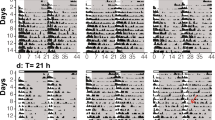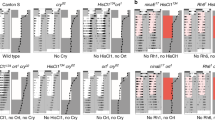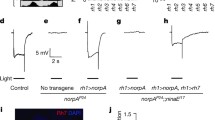Abstract
The mechanisms that synchronize the biorhythms of the mammalian retina with the light/dark cycle are independent of those synchronizing the rhythms in the central pacemaker, the suprachiasmatic nucleus. The identity of the photoreceptor(s) responsible for the light entrainment of the retina of mammals is still a matter of debate, and recent studies have reported contradictory results in this respect. Here, we suggest that cryptochromes (CRY), in particular CRY 2, are involved in that light entrainment. CRY are highly conserved proteins that are a key component of the cellular circadian clock machinery. In plants and insects, they are responsible for the light entrainment of these biorhythms, mediated by the light response of their flavin cofactor (FAD). In mammals, however, no light-dependent role is currently assumed for CRY in light-exposed tissues, including the retina. It has been reported that FAD influences the function of mammalian CRY 2 and that human CRY 2 responds to light in Drosophila, suggesting that mammalian CRY 2 keeps the ability to respond to light. Here, we hypothesize that CRY 2 plays a role in the light entrainment of retinal biorhythms, at least in diurnal mammals. Indeed, published data shows that the light intensity dependence and the wavelength sensitivity commonly reported for that light entrainment fits the light sensitivity and absorption spectrum of light-responsive CRY. We propose experiments to test our hypothesis and to further explore the still-pending question of the function of CRY 2 in the mammalian retina.




Similar content being viewed by others
References
Astiz M, Heyde I, Oster H (2019) Mechanisms of communication in the mammalian circadian timing system. Int J Mol Sci 20:E343. https://doi.org/10.3390/ijms20020343
Husse J, Eichele G, Oster H (2015) Synchronization of the mammalian circadian timing system: light can control peripheral clocks independently of the SCN clock: alternate routes of entrainment optimize the alignment of the body’s circadian clock network with external time. BioEssays 37:1119–1128. https://doi.org/10.1002/bies.201500026
Welz PS, Zinna VM, Symeonidi A, Koronowski KB, Kinouchi K, Smith JG, Guillén IM, Castellanos A, Furrow S, Aragón F, Crainiciuc G, Prats N, Caballero JM, Hidalgo A, Sassone-Corsi P, Benitah SA (2019) BMAL1-driven tissue clocks respond independently to light to maintain homeostasis. Cell 177:1436–1447. https://doi.org/10.1016/j.cell.2019.05.009
Fan SM, Chang YT, Chen CL, Wang WH, Pan MK, Chen WP, Huang WY, Xu Z, Huang HE, Chen T, Plikus MV, Chen SK, Lin SJ (2018) External light activates hair follicle stem cells through eyes via an ipRGC-SCN-sympathetic neural pathway. Proc Natl Acad Sci USA 115:E6880–E6889. https://doi.org/10.1073/pnas.1719548115
Buhr ED, Vemaraju S, Diaz N, Lang RA, Van Gelder RN (2019) Neuropsin (OPN5) mediates local light-dependent induction of circadian clock genes and circadian photoentrainment in exposed murine skin. Curr Biol 29:1–10. https://doi.org/10.1016/j.cub.2019.08.063
Tosini G, Menaker M (1996) Circadian rhythms in cultured mammal retina. Science 272:419–421. https://doi.org/10.1126/science.272.5260.419
Owens L, Buhr ED, Tu DC, Lamprecht TL, Lee J, Van Gelder RN (2012) Effect of circadian clock gene mutations on nonvisual photoreception in the mouse. Investig Ophthalmol Vis Sci 53:454–460. https://doi.org/10.1167/iovs.11-8717
Buhr ED, Van Gelder RN (2014) Local photic entrainment of the retinal circadian oscillator in the absence of rods, cones, and melanopsin. Proc Natl Acad Sci USA 111:8625–8630. https://doi.org/10.1073/pnas.1323350111
Felder-Schmittbuhl MP, Buhr ED, Dkhissi-Benyahya O, Hicks D, Peirson SN, Ribelayga CP, Sandu C, Spessert R, Tosini G (2018) Ocular clocks: adapting mechanisms for eye functions and health. Investig Ophthalmol Vis Sci 59:4856–4870. https://doi.org/10.1167/iovs.18-24957
Tosini G, Menaker M (1998) The clock in the mouse retina: melatonin synthesis and photoreceptor degeneration. Brain Res 789:221–228. https://doi.org/10.1016/s0006-8993(97)01446-7
Buhr ED, Yue WW, Ren X, Jiang Z, Liao HW, Mei X, Vemaraju S, Nguyen MT, Reed RR, Lang RA, Yau KW, Van Gelder RN (2015) Neuropsin (OPN5)-mediated photoentrainment of local circadian oscillators in mammalian retina and cornea. Proc Natl Acad Sci USA 112:13093–13098. https://doi.org/10.1073/pnas.1516259112
Calligaro H, Coutanson C, Najjar RP, Mazzaro N, Cooper HM, Haddjeri N, Felder-Schmittbuhl MP, Dkhissi-Benyahya O (2019) Rods contribute to the light-induced phase shift of the retinal clock in mammals. PLoS Biol 17:e2006211. https://doi.org/10.1371/journal.pbio.2006211
Ruan GX, Allen GC, Yamazaki S, McMahon DG (2008) An autonomous circadian clock in the inner mouse retina regulated by dopamine and GABA. PLoS Biol 6:e249. https://doi.org/10.1371/journal.pbio.0060249
Peirson SN, Brown LA, Pothecary CA, Benson LA, Fisk AS (2018) Light and the laboratory mouse. J Neurosci Methods 15(300):26–36. https://doi.org/10.1016/j.jneumeth.2017.04.007
Brown TM (2016) Using light to tell the time of day: sensory coding in the mammalian circadian visual network. J Exp Biol 219(Pt 12):1779–1792. https://doi.org/10.1242/jeb.132167
Haltaufderhyde K, Ozdeslik RN, Wicks NL, Najera JA, Oancea E (2015) Opsin expression in human epidermal skin. Photochem Photobiol 91:117–123. https://doi.org/10.1111/php.12354
Spitschan M (2019) Melanopsin contribution to non-visual and visual function. Curr Opin Behav Sci 30:67–72. https://doi.org/10.1016/j.cobeha.2019.06.004
Kojima D, Mori S, Torii M, Wada A, Morishita R, Fukada Y (2011) UV-sensitive photoreceptor protein OPN5 in humans and mice. PLoS One 6:e26388. https://doi.org/10.1371/journal.pone.0026388
Liu H, Zhong D, Lin C (2010) Searching for a photocycle of the cryptochrome photoreceptors. Curr Opin Plant Biol 13:578–586. https://doi.org/10.1016/j.pbi.2010.09.005
Hut RA, Scheper A, Daan S (2000) Can the circadian system of a diurnal and a nocturnal rodent entrain to ultraviolet light ? J Comp Physiol A 186:707–715
Mure LS, Le HD, Benegiamo G, Chang MW, Rios L, Jillani N, Ngotho M, Kariuki T, Dkhissi-Benyahya O, Cooper HM, Panda S (2018) Diurnal transcriptome atlas of a primate across major neural and peripheral tissues. Science 359:eaao0318. https://doi.org/10.1126/science.aao0318
Lall GS, Revell VL, Momiji H, Al Enezi J, Altimus CM, Güler AD, Aguilar C, Cameron MA, Allender S, Hankins MW, Lucas RJ (2010) Distinct contributions of rod, cone, and melanopsin photoreceptors to encoding irradiance. Neuron 66:417–428. https://doi.org/10.1016/j.neuron.2010.04.037
Oztürk N, Song SH, Ozgür S, Selby CP, Morrison L, Partch C, Zhong D, Sancar A (2007) Structure and function of animal cryptochromes. Cold Spring Harb Symp Quant Biol 72:119–131. https://doi.org/10.1101/sqb.2007.72.015
Chaves I, Pokorny R, Byrdin M, Hoang N, Ritz T, Brettel K, Essen LO, van der Horst GT, Batschauer A, Ahmad M (2011) The cryptochromes: blue light photoreceptors in plants and animals. Annu Rev Plant Biol 62:335–364. https://doi.org/10.1146/annurev-arplant-042110-103759
Czarna A, Berndt A, Singh HR, Grudziecki A, Ladurner AG, Timinszky G, Kramer A, Wolf E (2013) Structures of Drosophila cryptochrome and mouse cryptochrome1 provide insight into circadian function. Cell 153:1394–1405. https://doi.org/10.1016/j.cell.2013.05.011
Zoltowski BD, Chelliah Y, Wickramaratne A, Jarocha L, Karki N, Xu W, Mouritsen H, Hore PJ, Hibbs RE, Green CB, Takahashi JS (2019) Chemical and structural analysis of a photoactive vertebrate cryptochrome from pigeon. Proc Natl Acad Sci USA. https://doi.org/10.1073/pnas.1907875116
Liu Q, Wang Q, Deng W, Wang X, Piao M, Cai D, Li Y, Barshop WD, Yu X, Zhou T, Liu B, Oka Y, Wohlschlegel J, Zuo Z, Lin C (2017) Molecular basis for blue light-dependent phosphorylation of Arabidopsis cryptochrome 2. Nat Commun 8:15234. https://doi.org/10.1038/ncomms15234
Weidler G, Zur Oven-Krockhaus S, Heunemann M, Orth C, Schleifenbaum F, Harter K, Hoecker U, Batschauer A (2012) Degradation of Arabidopsis CRY2 is regulated by SPA proteins and phytochrome A. Plant Cell 24:2610–2623. https://doi.org/10.1105/tpc.112.098210
Gustafson CL, Partch CL (2015) Emerging models for the molecular basis of mammalian circadian timing. Biochemistry 54:134–149. https://doi.org/10.1021/bi500731f
Wong JCY, Smyllie NJ, Banks GT, Pothecary CA, Barnard AR, Maywood ES, Jagannath A, Hughes S, van der Horst GTJ, MacLaren RE, Hankins MW, Hastings MH, Nolan PM, Foster RG, Peirson SN (2018) Differential roles for cryptochromes in the mammalian retinal clock. FASEB J 32:4302–4314. https://doi.org/10.1096/fj.201701165RR
Thompson CL, Bowes Rickman C, Shaw SJ, Kelly U, Sancar A, Rickman DW (2003) Expression of the blue-light receptor cryptochrome in the human retina. Investig Ophthalmol Vis Sci 44:4515–4521. https://doi.org/10.1167/iovs.03-0303
Wang X, Jing C, Selby CP, Chiou YY, Yang Y, Wu W, Sancar A, Wang J (2018) Comparative properties and functions of type 2 and type 4 pigeon cryptochromes. Cell Mol Life Sci 75:4629–4641. https://doi.org/10.1007/s00018-018-2920-y
Partch CL, Sancar A (2005) Cryptochromes and circadian photoreception in animals. Methods Enzymol 393:726–745. https://doi.org/10.1016/S0076-6879(05)93038-3
Van Gelder RN, Wee R, Lee JA, Tu DC (2003) Reduced pupillary light responses in mice lacking cryptochromes. Science 299:222. https://doi.org/10.1126/science.1079536
Hore PJ, Mouritsen H (2016) The radical-pair mechanism of magnetoreception. Annu Rev Biophys 45:299–344. https://doi.org/10.1146/annurev-biophys-032116-094545
Kattnig DR, Evans EW, Déjean V, Dodson CA, Wallace MI, Mackenzie SR, Timmel CR, Hore PJ (2016) Chemical amplification of magnetic field effects relevant to avian magnetoreception. Nat Chem 8:384–391. https://doi.org/10.1038/nchem.2447
Sheppard DM, Li J, Henbest KB, Neil SR, Maeda K, Storey J, Schleicher E, Biskup T, Rodriguez R, Weber S, Hore PJ, Timmel CR, Mackenzie SR (2017) Millitesla magnetic field effects on the photocycle of an animal cryptochrome. Sci Rep 7:42228. https://doi.org/10.1038/srep42228
Günther A, Einwich A, Sjulstock E, Feederlee R, Bolte P, Koch KW, Solov’yov IA, Mouritsen H (2018) Double-cone localization and seasonal expression pattern suggest a role in magnetoreception for European robin cryptochrome 4. Curr Biol 28:211–223. https://doi.org/10.1016/j.cub.2017.12.003
Begall S, Malkemper EP, Ceverny J, Nemec P, Burda H (2013) Magnetic alignment in mammals and other animals. Mammal Biol 78:10–20. https://doi.org/10.1016/j.mambio.2012.05.005
Begall S, Burda H, Malkemper EP (2014) Magnetoreception in mammals. In: Naguib M (ed) Advances in the study of behavior, vol 46. Elsevier, Amsterdam, pp 45–88. https://doi.org/10.1016/B978-0-12-800286-5.00002-X
Hirano A, Braas D, Fu YH, Ptáček LJ (2017) FAD regulates cryptochrome protein stability and circadian clock in mice. Cell Rep 19:255–266. https://doi.org/10.1016/j.celrep.2017.03.041
Kutta RJ, Archipowa N, Johannissen LO, Jones AR, Scrutton NS (2017) Vertebrate cryptochromes are vestigial flavoproteins. Sci Rep 7:44906. https://doi.org/10.1038/srep44906
Schmalen I, Reischl S, Wallach T, Klemz R, Grudziecki A, Prabu JR, Benda C, Kramer A, Wolf E (2014) Interaction of circadian clock proteins CRY1 and PER2 is modulated by zinc binding and disulfide bond formation. Cell 157:1203–1215. https://doi.org/10.1016/j.cell.2014.03.057
Xing W, Busino L, Hinds TR, Marionni ST, Saifee NH, Bush MF, Pagano M, Zheng N (2013) SCF(FBXL3) ubiquitin ligase targets cryptochromes at their cofactor pocket. Nature 496:64–68. https://doi.org/10.1038/nature11964
Hirano A, Shi G, Jones CR, Lipzen A, Pennacchio LA, Xu Y, Hallows WC, McMahon T, Yamazaki M, Ptáček LJ, Fu YH (2016) A cryptochrome 2 mutation yields advanced sleep phase in humans. Elife 5:e16695. https://doi.org/10.7554/eLife.16695
Hoang N, Schleicher E, Kacprzak S, Bouly JP, Picot M, Wu W, Berndt A, Wolf E, Bittl R, Ahmad M (2008) Human and Drosophila cryptochromes are light activated by flavin photoreduction in living cells. PLoS Biol 6:e160. https://doi.org/10.1371/journal.pbio.0060160
Foley LE, Gegear RJ, Reppert SM (2011) Human cryptochrome exhibits light-dependent magnetosensitivity. Nat Commun 2:356. https://doi.org/10.1038/ncomms1364
Fedele G, Edwards MD, Bhutani S, Hares JM, Murbach M, Green EW, Dissel S, Hastings MH, Rosato E, Kyriacou CP (2014) Genetic analysis of circadian responses to low frequency electromagnetic fields in Drosophila melanogaster. PLoS Genet 10:e1004804. https://doi.org/10.1371/journal.pgen.1004804
Reifler AN, Chervenak AP, Dolikian ME, Benenati BA, Meyers BS, Demertzis ZD, Lynch AM, Li BY, Wachter RD, Abufarha FS, Dulka EA, Pack W, Zhao X, Wong KY (2015) The rat retina has five types of ganglion-cell photoreceptors. Exp Eye Res 130:17–28. https://doi.org/10.1016/j.exer.2014.11.010
Zhao X, Stafford BK, Godin AL, King WM, Wong KY (2014) Photoresponse diversity among the five types of intrinsically photosensitive retinal ganglion cells. J Physiol 592:1619–1636. https://doi.org/10.1113/jphysiol.2013.262782
Mure LS, Hatori M, Zhu Q, Demas J, Kim IM, Nayak SK, Panda S (2016) Melanopsin-encoded response properties of intrinsically photosensitive retinal ganglion cells. Neuron 90:1016–1027. https://doi.org/10.1016/j.neuron.2016.04.016
Lucas RJ, Lall GS, Allen AE, Brown TM (2012) How rod, cone, and melanopsin photoreceptors come together to enlighten the mammalian circadian clock. Prog Brain Res 199:1–18. https://doi.org/10.1016/B978-0-444-59427-3.00001-0
Pérez-Fernández V, Milosavljevic N, Allen AE, Vessey KA, Jobling AI, Fletcher EL, Breen PP, Morley JW, Cameron MA (2019) Rod photoreceptor activation alone defines the release of dopamine in the retina. Curr Biol 29(763–774):e5. https://doi.org/10.1016/j.cub.2019.01.042
Collins B, Mazzoni EO, Stanewsky R, Blau J (2006) Drosophila cryptochrome is a circadian transcriptional repressor. Curr Biol 16:441–449. https://doi.org/10.1016/j.cub.2006.01.034
Rosensweig C, Reynolds KA, Gao P, Laothamatas I, Shan Y, Ranganathan R, Takahashi JS, Green CB (2018) An evolutionary hotspot defines functional differences between cryptochromes. Nat Commun 9:1138. https://doi.org/10.1038/s41467-018-03503-6
Kaladchibachi S, Negelspach DC, Fernandez F (2018) Circadian phase-shifting by light: beyond photons. Neurobiol Sleep Circadian Rhythms 5:8–14. https://doi.org/10.1016/j.nbscr.2018.03.003
Vinayak P, Coupar J, Hughes SE, Fozdar P, Kilby J, Garren E, Yoshii T, Hirsh J (2013) Exquisite light sensitivity of Drosophila melanogaster cryptochrome. PLoS Genet 9:e1003615. https://doi.org/10.1371/journal.pgen.100361
Michael AK, Fribourgh JL, Van Gelder RN, Partch CL (2017) Animal cryptochromes: divergent roles in light perception, circadian timekeeping and beyond. Photochem Photobiol 93:128–140. https://doi.org/10.1111/php.12677
Selby CP, Thompson C, Schmitz TM, Van Gelder RN, Sancar A (2000) Functional redundancy of cryptochromes and classical photoreceptors for nonvisual ocular photoreception in mice. Proc Natl Acad Sci USA 97:14697–14702. https://doi.org/10.1073/pnas.260498597
Thompson CL, Blaner WS, Van Gelder RN, Lai K, Quadro L, Colantuoni V, Gottesman ME, Sancar A (2001) Preservation of light signaling to the suprachiasmatic nucleus in vitamin A-deficient mice. Proc Natl Acad Sci USA 98:11708–11713. https://doi.org/10.1073/pnas.201301498
Thompson CL, Selby CP, Van Gelder RN, Blaner WS, Lee J, Quadro L, Lai K, Gottesman ME, Sancar A (2004) Effect of vitamin A depletion on nonvisual phototransduction pathways in cryptochromeless mice. J Biol Rhythms 19:504–517. https://doi.org/10.1177/0748730404270519
Vanderstraeten J, Gailly P, Malkemper EP (2018) Low-light dependence of the magnetic field effect on cryptochromes: possible relevance to plant ecology. Front Plant Sci 9:121. https://doi.org/10.3389/fpls.2018.00121
Acknowledgements
We are indebted to Martha Daniel for proof reading the manuscript and thankful to three anonymous referees for helpful comments that improved the quality of the manuscript.
Author information
Authors and Affiliations
Contributions
JV developed the hypothesis. All authors wrote the manuscript.
Corresponding author
Ethics declarations
Conflict of interest
The authors declare there is no conflict of interest regarding the publication of this article.
Additional information
Publisher's Note
Springer Nature remains neutral with regard to jurisdictional claims in published maps and institutional affiliations.
Rights and permissions
About this article
Cite this article
Vanderstraeten, J., Gailly, P. & Malkemper, E.P. Light entrainment of retinal biorhythms: cryptochrome 2 as candidate photoreceptor in mammals. Cell. Mol. Life Sci. 77, 875–884 (2020). https://doi.org/10.1007/s00018-020-03463-5
Received:
Revised:
Accepted:
Published:
Issue Date:
DOI: https://doi.org/10.1007/s00018-020-03463-5




